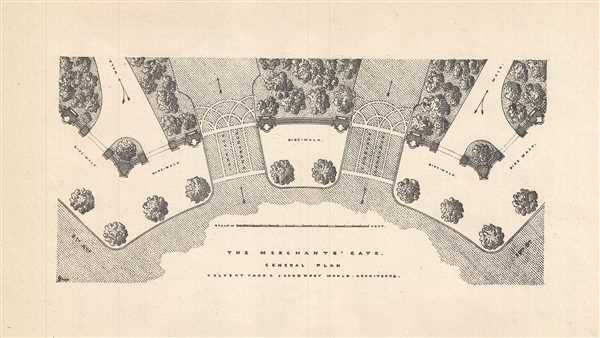This item has been sold, but you can get on the Waitlist to be notified if another example becomes available, or purchase a digital scan.
1860 Vaux Plan of the Merchant's Gate in Central Park, New York City (Columbus Circle)
MerchantsGate-vaux-1860
Title
1860 (undated) 4 x 7.5 in (10.16 x 19.05 cm)
Description
Vaux and Olmsted were awarded the task of designing Central Park in 1853 by the City Common Council. Olmsted's vision drove the overall design while Vaux concentrated his attentions on entrances, bridges, buildings, and other structures within the park. The creation of Central Park, which was to consist of some 800 acres of public forest, pathways, promenades, lakes, bridges, and meadows, was a seminal moment in civic urban design. The park itself was designed as a whole with every tree, pond, and bench meticulously planned. Olmsted wrote: 'Every foot of the parks surface, every tree and bush, as well as every arch, roadway, and walk and been placed where it is for a purpose.'
Historian Gloria Deak writes,
There was a staggering amount of work to be done to transform the area into a blend of pastoral and woodland scenery. This involved the design and construction of roadways, tunnels, bridges, arches, stairways, fountains, benches, lamp posts, gates, fences and innumerable other artifacts. It also involved the supervision of an army of about five thousand laborers…Olmsted, to whom most of the credit goes, insisted on seeing the multidimensional project as a single work of art, which he was mandated to create. For this purpose, he ventured to assume to himself the title of 'artist.'Today, because of Vaux and Olmsted's efforts, New York Yorkers, ourselves included, have the privilege of enjoying what is, perhaps, the finest example of a planned urban public recreation area in the world.
Cartographer
Calvert Vaux (1824 - 1895) was a British architect and landscaper who is best remembered for his co-design, with Frederick Olmstead, of New York City's Central Park. Born in London in 1824, little is known of his early life, though it is recorded that, at 9 he was apprenticed to London architect Lewis Nockalls Cottingham, a proponent of the Gothic Revival Movement. Vaux worked for Cottingham until he was 26 years old, honing his skills and building a reputation as a skilled draftsman. During an exhibition of his watercolors in 1851, Vaux caught the attention of landscape designer Andrew Jackson Downing. Downing was looking for a partner to fulfill his revolutionary vision of urban architectural-landscaping. Dowing recruited Vaux to design buildings, bridges, and structures, while he focused on the overall landscape design. Vaux accompanied Downing to the United States where, in 1854, he gained U.S. citizenship and founded the American Institute of Architects. Vaux's partnership with Downing lasted approximately two years and resulted in a number of significant works, including the grounds of the White and Smithsonian Institute in Washington D.C. In 1852 Downing passed away in a tragic accident. At the time Downing was working on a landscape design for New York City's Central Park. In a decision that would forever change the American urban landscape, Vaux called in the fledgling landscape designer Frederick Olmstead to fill Downing shoes. Though Central Park was their first joint project, Vaux and Olmstead proved a magical combination, creating what many consider to be the finest planed urban recreation area in the world. Following the completion of Central Park, Vaux and Olmstead formed an official business partnership and went on to design Prospect Park in Brooklyn and Morningside Park in upper Manhattan. They planned one of the first suburbs in Chicago, Riverside, and were commissioned to design parks for Buffalo, NY, Milwaukee, WI, and Rockwood Park in Canada, among others. Vaux ended the partnership in 1872 and went on to collaborate with George Kent Radford and Samuel Parsons. However, in 1889 he again joined forces with Olmstead to design Downing Park, as a memorial to his mentor. Vaux tragically passed away on November 19, 1895, when he drowned in Brooklyn, NY. More by this mapmaker...

